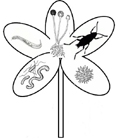
Editorial Board
Evaluation Reviewers
Instructions to Authors
Evaluation Process
Paper Submission
Objective & Policy
Number of visits :
- Current Issue -

- Previous Issue -


Last update : June 2025
- Recent Doctorates -
Recent Doctorate Theses in Plant Protection (2024/25)
Tissaoui-Ben Ammar, Salma. 2024. Wheat-Pyrenophora tritici-repentis interaction: Disease mapping, characterization of the causal agent and study of host resistance. Doctorate Thesis in Agronomic Sciences (Phytiatry), INAT, University of Carthage, Tunis, Tunisia, 171 pp. (Public Defense: 22 November 2024).
Tan spot, caused by the Ascomycete Pyrenophora tritici-repentis (Ptr), has become a wheat disease frequently observed in several cereal regions in northern of Tunisia during the last decade. It had therefore become necessary to study the interaction Wheat-P. tritici-repentis in order to develop an effective control strategy. Surveys carried out in several fields belonging to the northern regions, allowed us to record high percentages of the prevalence, incidence, and severity of the disease in the sub-humid regions compared to those of the medium semi-arid. The analysis of the data using a mathematical model of logistic regression showed a significant effect of climatic conditions and agronomic practices on the disease progression. Likewise, disease intensity had a high probability of correlation with humidity, high rainfall, monoculture, susceptible varieties, and sub-humid bioclimatic region. The characterization of Ptr isolates collection based on the morphology of the fungal colonies, and the pathogenicity, showed a significant difference. The virulence characterization of the isolates carried out by artificial inoculation of a differential set of wheat genotypes and by determination of the necrotrophic effector genes ToxA, and ToxB and toxb encoding host-specific toxins, revealed the identification of four races namely 4, 5, 7, and an atypical race with the predominance of races 5 and the atypical one. Hence, the existing pathogen population in our fields are characterized by a variable virulence structure and the appearance of a new virulence profile. In addition, the genotypic analysis of ninety-six isolates using eight microsatellite pairs showed high genetic diversity, which implies an evolutionary capacity of the pathogen, and a grouping of isolates according to fungicide treatments suggesting unusual behavior to fungicide treatments, which constitutes a novelty in the study of the epidemiology of the disease in Tunisia. The determination of the reaction of commercial varieties of durum and bread wheat to the distinct pathogenic races based on the evaluation of the disease progression (AUDPC) in the field during two successive seasons and yield parameters, showed that the varieties of bread wheat and the majority of those of durum wheat presented a resistance reaction to the pathogen. In addition, these varieties carried tsn1 and tsc2 insensitivity genes to toxins ToxA, and ToxB, respectively. Therefore, screening for resistant varieties could constitute a major element when establishing an effective and sustainable control program against the disease.